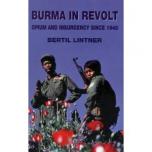Burma in Revolt; Opium and Insurgency Since 1948
This is perhaps the most authoritative and useful books on the subjects of insurgency and the drug trade in Burma. At over 500 pages including 5 Appendices and complete with index, bibliography, maps, time lines and photographs the book’s main attraction is the thorough and well researched material that Lintner has managed to accrue over decades of travel across the top of Myanmar particularly the Shan States. A high regard for his published work on the drug trade in Asia puts him at the top of his field.
This volume begins at 1948 which is particularly significant for its relevance to the fight for Shan independence. A preamble which looks at Burma since its occupation by the British Raj in the late 19th century, followed by fledgling independence groups, the Second World War and its aftermath brings us to the start of the period covered in thorough detail. I read the volume straight from cover to cover and it is a very dense book which takes quite some work.
It is indispensable as a reference volume for anyone maintaining an interest in the region and for anyone interested in the various players in the events. The Burmese Military and their associates who appear to consist of criminal thugs who aren’t prepared to tolerate the existence of any Government control, the arrival of the Kuo Min Tang (KMT), Nationalist Chinese insurgents taking orders from Chiang Kai Shek in Taiwan who were trying to fight the Communists for control of the mainland by setting up bases in countries on the south of China’s border and infiltrating into Yunnan. This strategy was encouraged during the Korean War by the U.S. interests which were overwhelmed by the amount of support coming from the Peoples’ Republic and the Peoples Liberation Army (PLA). The ‘Second Front’ opened up by the KMT in the far south of Yunnan meant the PLA needed to maintain reserves remote from Korea, reducing those available to fight in the Korean War. The end of the Korean War didn’t spell the end of the KMT or U.S. interests in the region and Lintner provides an exhaustive and detailed account of the relationships between the major players; the Thai Army, U.S. agents and a variety of local armed groups who actually lived in the region and were important for logistical reasons among others.
The Burmese Army became more and more demanding. After starting by assassinating the legal Government along with the leader Bogyoke Aung San, the Father of the Federation, and eventually staging a coup in 1962 which plunged a country with ample resources and good prospects including the title of world’s leading rice exporter into a state of increasing recession and repression. The events take place in a rich tapestry of ethnic minorities each wanting to ensure they keep a meaningful degree of control over their territory and lives while the Burmese Army racks up a growing list of human rights violations and ethnic cleansing.
After decades of internecine military struggle the ethnic rebels have begun to sign ceasefire agreements and are trying to come to a political solution. Any really significant concessions by the Military are yet to become apparent and despite what the Government might agree to it is the Army or Tatmadaw which calls the shots. The book looks at the rise of the Democracy Movement, mainly the National League for Democracy, Daw Suu Kyi daughter of Aung San as spokesperson for the movement continually refers to the need for the ethnic minorities to have their own interests respected in a democratic Burma and this book concurs. In respect to the drug trade Lintner makes it clear that the primary cause for the expansion of an already substantial drug economy is the absolute power of the military. A work that earns high praise from individuals who have spent their lives associated with the topic.

Recent comments